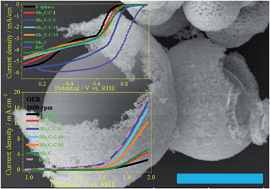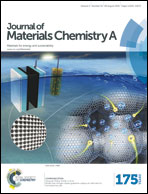In situ preparation of hollow Mo2C–C hybrid microspheres as bifunctional electrocatalysts for oxygen reduction and evolution reactions†
Abstract
The sluggish kinetics of the oxygen reduction reaction (ORR) and oxygen evolution reaction (OER) has been one of the bottlenecks hindering the commercial application of rechargeable metal–air batteries. It is urgent and necessary to develop non-noble bifunctional catalysts for both the ORR and the OER with high catalytic activity. Herein, an in situ synthetic route to obtain Mo2C–C hybrid microspheres as bifunctional catalysts has been reported. In this route, the synchronously prepared C microspheres act not only as the template, but also as the reactant. Interestingly, SEM, TEM and XPS results show that core–shell, yolk–shell and pierced structured microspheres could be formed by increasing the content of Mo2C in the Mo2C–C hybrids. Additionally, the formation of a non-crystalline amorphous MoOx (MoO2 and MoO3) nano-film appears to improve the conductivity of the as-prepared Mo2C–C hybrids. Rotating-ring-disk electrode (RRDE) results show that the Mo2C–C hybrids exhibit enhanced catalytic activity for the ORR and OER compared with that of the C microspheres and Mo2C. In particular, Mo2C–C-5 displays excellent bifunctional activity and stability, which is close to the behavior of a commercial Pt/C electrocatalyst for the ORR and a RuO2 electrocatalyst for the OER.



 Please wait while we load your content...
Please wait while we load your content...